When Nvidia CEO Jensen Huang revealed on Friday last week that the company is working with the Trump administration on a new computer chip designed for sale to China, it marked the latest chapter in a long-running debate over how the US should compete with China’s technological ambitions.
The reasoning has sometimes changed — with US officials citing national security, human rights or purely economic competition — but the tool has been the same: export controls, or the threat of them.
Nvidia believes it can eventually reap US$50 billion from artificial intelligence (AI) chip sales in China. But it so far has been held back by restrictions imposed by former US president Joe Biden’s administration and then reinforced by US President Donald Trump before negotiating a quid pro quo deal.

Photo: AFP 照片:法新社
HOW DID THESE CHIP EXPORT CONTROLS START?
China has its own chip foundries, but they have historically supplied only low-end processors used in autos and appliances. Beginning in 2014, the Chinese government tried to change that with a new “Big Fund” that invested huge amounts of money into hundreds of semiconductor companies.
Meanwhile, the US government, starting in Trump’s first term, began cutting off China’s access to a growing array of tools to make chips for computer servers, artificial intelligence and other advanced applications.
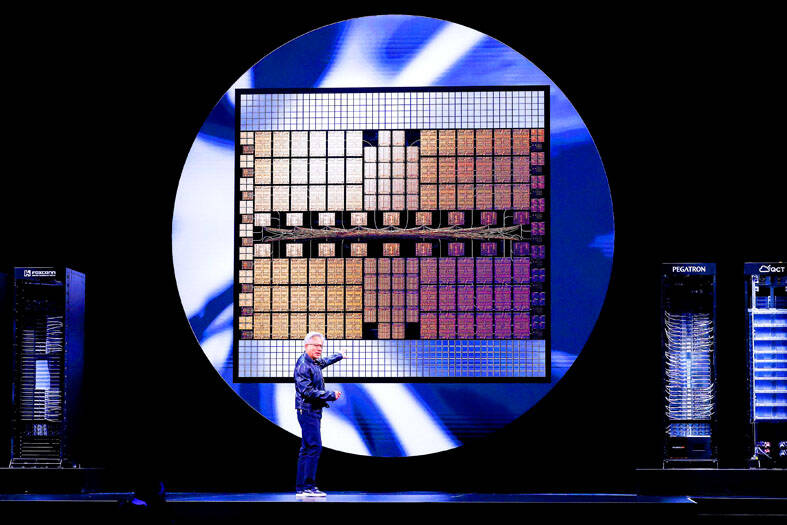
Photo: Reuters 照片:路透
China was particularly irked when it was blocked from buying a machine available only from a Dutch company, ASML, that uses ultraviolet light to etch circuits into silicon chips. The restrictions stalled Chinese efforts to make transistors faster and more efficient by packing them more closely together on fingernail-size slivers.
Chinese telecommunications giant Huawei became the public face of the trade tensions, with US claims of its products’ potential use for espionage a backdrop for a broader struggle for economic and technological dominance.
“We don’t want their equipment in the United States because they spy on us,” Trump said in 2020 as the administration tightened restrictions to block Huawei from accessing chip technology, at the same time as he was threatening to ban TikTok on similar grounds.
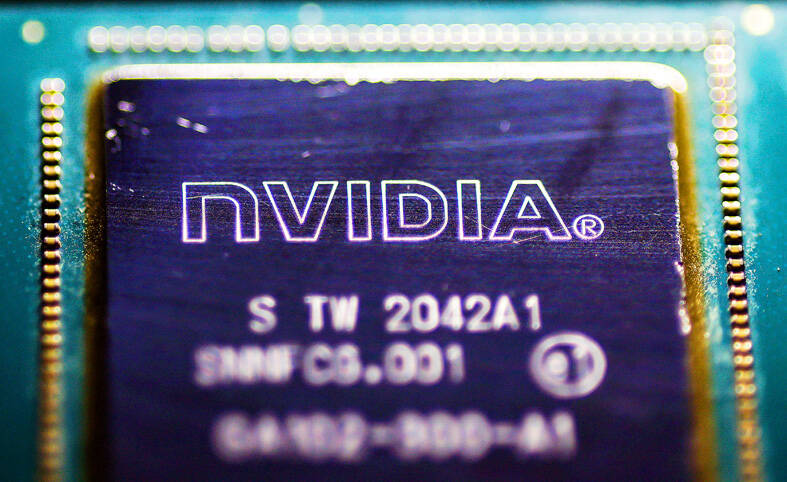
Photo: EPA 照片:歐新社
BIDEN UPS THE ANTE ON CHIP RESTRICTIONS
Biden maintained those restrictions after taking office in 2021, but also ramped them up with a series of export controls that blocked sending to China the world’s most advanced chips and factory equipment.
That affected Chinese sales for California chipmaker Nvidia, the leading designer of the specialized chips needed for AI technology.
After the first restrictions took effect in 2022, blocking chips including Nvidia’s H100, the company designed a new kind of chip that was not quite advanced enough to meet the threshold for restrictions.
The Biden administration escalated its restrictions in 2023 to block those newer chips. Then Nvidia again came out with a new kind of chip that could slip into China: the H20.
TRUMP’S BACK-AND-FORTH ON THE H20
The Trump administration in April halted the sale of the H20 and other advanced computer chips to China over national security concerns, but Nvidia and AMD revealed in July that Washington would allow them to resume sales of their chips, which are used in AI development.
After taking a US$4.5 billion blow to its finances during the February-April period, Nvidia estimated the export crackdown in China would cost the company another US$8 billion in potential sales from May through July.
The squandered opportunities fueled Huang’s efforts to persuade Trump and other administration officials that the restraints would do more harm than good for the US.
“The question is not whether China will have AI, it already does,” Huang told analysts during a conference call in late May. “The question is whether one of the world’s largest AI markets will run on American platforms. Shielding Chinese chipmakers from US competition only strengthens them abroad and weakens America’s position.”
Nvidia and AMD also agreed in August to share 15 percent of their revenues from chip sales to China with the US government, as part of a deal to secure export licenses for the semiconductors.
(AP)
輝達(Nvidia)執行長黃仁勳上週五透露,輝達正與川普政府合作開發一款專門在中國市場銷售的新型晶片;面對中國發展科技的野心,美國思考因應之道已久,此舉意味美中科技戰邁入新階段。
美國雖然用過不同的理由——國安考量、人權問題,有時則是單純的經濟競爭——但手段始終相同,即出口管制,或至少是威脅採取出口管制。
輝達認為,該公司的人工智慧晶片在中國會有500億美元的市場。然而,由於美國前總統拜登政府設下的限制,之後川普政府又進一步加強管制力道,而受到了阻礙,直到川普政府談判的「交換條件」才有所改變。
晶片出口管制從何而起?
中國雖有自己的晶圓代工廠,但歷來僅能生產用於汽車、家電的低階處理器。自2014年起,中國政府試圖改變此情況,推出「大基金」,向數百家半導體公司投入巨額資金。
與此同時,美國政府自川普第一任期開始,逐步切斷中國取得晶片生產工具之管道,使其無法製造用於伺服器、人工智慧及其他先進應用之晶片。
其中最令中國不滿的,是被禁止購買荷蘭艾司摩爾(ASML)公司獨家生產的極紫外光(EUV)微影製程機台,該機器能將電路精細地刻蝕到矽晶片上。此限令讓中國無法在指甲大小的晶片上更緊密地堆疊電晶體,提升速度與效率。
中國電信巨頭華為則成為這貿易緊張局勢下的代表性企業。美國稱華為產品可能被用於間諜活動,華為成了更廣泛的經濟與科技主導權爭霸的縮影。
川普在2020年曾說:「我們不要他們的設備進入美國,因為他們會監視我們」。當時,美國政府進一步加強對華為的限制,禁止其取得先進晶片技術,並同時以類似的理由威脅要封殺TikTok。
拜登對晶片出口加強管制
拜登2021年上任後,延續了川普的政策,並加碼實施多項出口管制,禁止將全球最先進的晶片及製造設備輸往中國。
這影響了加州晶片製造商輝達在中國的銷售,輝達是人工智慧專用晶片最重要的設計公司。
自2022年第一波限令生效後,輝達的H100晶片被禁止出口。該公司隨即設計了一款新晶片,其性能略低於限制門檻,得以繞過規範。
然而,拜登政府在2023年再度加強限制,將這款新晶片也列入禁止出口清單。輝達之後又開發了另一款名為H20的晶片,希望藉此重返中國市場。
川普對H20晶片的反覆態度
川普政府今年4月出於國安疑慮,暫停H20及其他先進晶片銷往中國。但到了7月,輝達與超微(AMD)宣布,華府將准許它們恢復晶片銷售,因為這些晶片在人工智慧的開發中不可或缺。
輝達在2至4月財報中已因出口受阻而蒙受45億美元損失,且估計在5至7月期間,對中國的出口封鎖將再損失價值80億美元的市場。
這些錯失的商機,促使黃仁勳更加積極遊說川普及其他政府官員:過度的限制,對美國反而是弊大於利。
黃仁勳在5月底的視訊會議中對分析師表示:「問題不在於中國會不會有AI,他們已經有了。真正的問題是,全球最大的AI市場之一,是否會在美國的平台上運作。若要中國晶片商不跟美國競爭,反而會壯大他們在海外的力量,削弱美國的地位」。
此外,輝達與超微在8月同意,將其對中國晶片銷售的15% 營收,上繳給美國政府,以換取半導體出口中國的許可。
(台北時報林俐凱編譯)
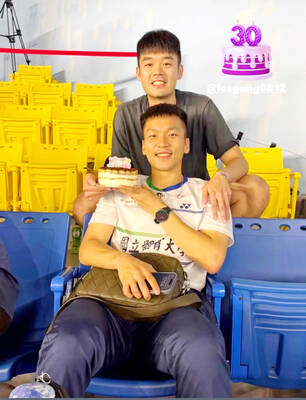
A: The Ministry of Education’s Sports Administration has been upgraded to the Cabinet’s Ministry of Sports, which came into operation on Sept. 9, National Sports Day. B: Yeah, Olympic gold medalist Lee Yang was appointed minister, while baseball superstar Chen Yi-hsin was appointed deputy minister of the Council of Indigenous Peoples. A: Lee won gold in badminton men’s doubles at the 2021 Tokyo Olympics and the 2024 Paris Olympics. Born in 1995, he just turned 30 — that makes him the youngest minister ever. B: In order to serve the country, the news says Lee even gave up commercial
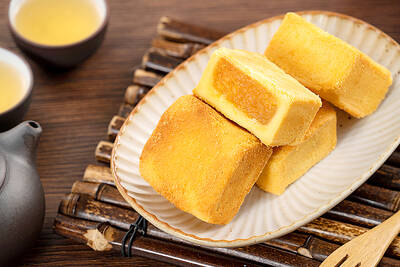
本文由生成式AI協作,本刊編輯編修。 The name of a dish often provides clues about what to expect. Names can paint a vivid picture, but they may also be misleading when they have little to do with what’s actually on the plate. Some people have shared their personal experiences of such dishes on social media. (A) Dolly I’ll never forget the sense of betrayal I felt when I first ate Taiwan’s pineapple cake because there was barely any pineapple inside! When I questioned the store clerk, she explained that early pineapple cakes blended winter melon with pineapple to reduce acidity. Many producers now eliminate the sour fruit entirely

A: According to the Ministry of Sports, 35.3 percent of the Taiwanese exercise regularly in line with the “7-3-3-3” principle. B: The “7-3-3-3” principle? A: It means exercising more than three times a week, for over 30 minutes each time – with a heart rate of 130bpm, sweating and breathing heavily during exercise. B: I go swimming at least three times a week. I’m even going to the 2025 Sun Moon Lake International Swimming Carnival in Nantou next Sunday. A: Wow, you’re such a fitness enthusiast. I’ll go cheer you on, then. A: 根據運動部的「7-3-3-3」原則,台灣人規律運動比例達35.3%。 B: 什麼是「7-3-3-3」原則?
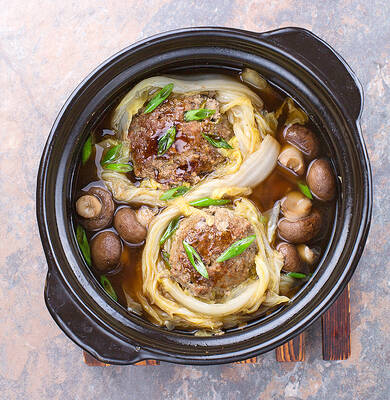
本文由生成式AI協作,本刊編輯編修。 Continued from yesterday(延續自昨日) https://www.taipeitimes.com/News/lang (D) Bonnie I was so confused when I was offered black pudding in the UK. I was expecting a sweet dessert, but it’s a type of blood sausage made mainly from pork blood, fat, and oatmeal, giving it a dark black color. The word “pudding” in its Latin meaning refers to sausage rather than dessert. (E) Lance When I saw the name Lion’s Head at a Chinese restaurant, I thought they served real lion meat and hesitated to order it. However, I learned from the waiter that the dish is composed of large meatballs surrounded by vegetables. Its name comes from